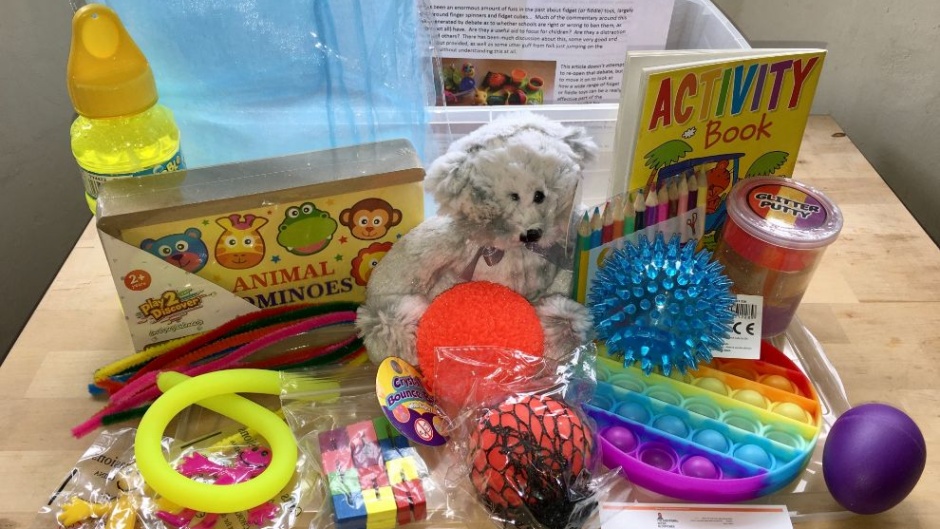A range of fidget or fiddle toys can be really effective for children’s and youth workers and families, offering them safe ways to meet the sensory needs that children have.
 Fiddle box. / Mark Arnold.
Fiddle box. / Mark Arnold.
All of us, whether adults or children, whether we have special needs or not, are sensory creatures.
We can all have senses that at times are under responsive (hyposensitive), or overly responsive (hypersensitive), meaning that we regularly, often subconsciously, are trying to balance our sensory systems.
This can sometimes take the form of sensory seeking, where we are trying to activate our senses in any way possible. How many times have we seen children swinging their feet or tapping their fingers, twirling their hair, biting their nails, tapping their pencil, or clicking their pen?
Maybe some of these are sensory seeking actions that we do too!
Often, in a children’s or youth work setting, or at home with our own children, there can be times when they are sensory seeking and this can sometimes lead to them searching for something to help them to regulate their senses.
In the absence of anything to support them, they may end up becoming distracted and disengaged, or even find the sensory input they need by using one of their peers as a fidget/fiddle item!
Providing a range of fidget or fiddle toys can be a really effective part of the resource toolkit for children’s and youth workers, or for families, offering children and young people safe ways to meet the sensory needs that they have, so let’s have a think about what things you might include in your fiddles box.
Each child or young person will, like all of us, have a favourite item that they will choose from the fiddles box; something that meets their sensory needs and helps them.
Having a selection of different items in your fiddles box will ensure that you’ve got something for everyone and if more than one child wants the same thing, well most items are fairly inexpensive so adding more to the box shouldn’t be difficult.
The variety of things to include can be up to each children’s or youth worker, or family and their children/young people, but here are a few suggestions:
Something you can twist; a string of wooden ‘twist and lock’ blocks that can be twisted into shapes, or pipe-cleaners can be bent or twisted into spirals and can be excellent for this.
Something you can stretch; stretchy ‘snakes’, or stretchy ‘people’, both work well.
Something you can squish/squeeze; modelling clay or putty is a favourite for this, and is the go-to item for my son James, but a soft mesh ball that you can squeeze is also good, as is a soft cuddly toy.
Something that has a little bit of weight; such as a bean bag or similar. If this is a sensory need that is regularly sought by a child, then a weighted lap pad or weighted blanket might be worth considering.
Something you can click, manipulate etc; the favourite item in this category at the moment is the pop/push sheets that are a bit like bubble wrap (see the rainbow version in the photo). Fidget cubes can be good for this too.
Sometimes children need something to do while they are listening. It can help them to have an activity that uses their hands while they take in what is being said.
A craft activity, some colouring, a jigsaw, ideally something that is themed around what they are listening to, all can help them to concentrate and focus. In more general-purpose fiddles boxes, I use an activity book and colouring pencils, or some wooden dominoes, for this.
Lots of other ideas are out there; what would the children in your group find helpful? What you have in your fiddles box might also depend on where you are going to use it; for example, think about whether you need items that are silent in use.
Also, if you have items in the box that light up, remember that while this might help ‘wake up’ some under responsive sensory systems, it can over stimulate others!
It is important that everyone has the opportunity to choose something from the fiddles box that will help them during the session. It shouldn’t only be available to some children or this risks building resentment.
Initially, the excitement of it all might make it a short-term distraction, but things will settle down quite quickly and then having access to the fiddles box will be normalised. Don’t forget to add extra of any items that are popular!
If you’re a children’s or youth worker, a great suggestion is to bring the fiddles box along to your next children’s or youth team meeting. Let your team choose something to fiddle with while you all talk (instead of their usual pen!)
It will soon be evident that this helps concentration and focus, rather than hindering it, and it’s a bit of harmless fun at the same time!
For more examples of a fiddles/fidget box as well as a video I’ve recorded about them (scroll to the bottom of the page), go here.
If you would like to order a fiddles/fidget box for your church, school, or to use at home, you can buy either a small individual fiddles/fidget pack or a larger fiddles/fidget pack here.
I hope you find these tips helpful, and look forward to hearing your stories as you create your own fiddles/fidget box and use it effectively in your setting!
Now, where did I put my stretchy snake…
Mark Arnold, Director of Additional Needs Ministry at Urban Saints. Arnold blogs at The Additional Needs Blogfather. This article was re-published with permission.

Las opiniones vertidas por nuestros colaboradores se realizan a nivel personal, pudiendo coincidir o no con la postura de la dirección de Protestante Digital.
Si quieres comentar o